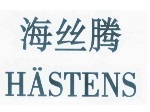Recently, the Supreme People's Court supported HӒSTENS' claim in a retrial judgment of trademark invalidation against the disputed trademark "海丝腾HӒSTENS" No. 9758664 (hereinafter referred to as the "disputed trademark") and decided that the disputed trademark used on the goods "clothing, etc." in Class 25 and the cited trademarks "海丝腾" (hai si teng) & "HӒSTENS" registered on "fabrics, etc." in Class 24, constitute similar trademarks used on similar goods, and that the registration of the disputed trademark violates Article 30 of China Trademark Law. The trademarks in dispute are shown as below:

(disputed trademark)

![]()
(cited trademarks)
In its judgment, the Supreme People's Court held that to determine if there is the likelihood of confusion, factors such as the similarity of trademark signs, the similarity of goods, the distinctiveness and reputation of the cited trademark, the attention of the relevant public, the subjective intention of the trademark applicant and the evidence of actual confusion should be considered.
The cited trademarks "海丝腾" (hai si teng) and " HӒSTENS " are composed of coined words or unique letter combinations without fixed meaning, and have strong distinctive characteristics. Although there are differences in functions and uses between the goods "clothing, hats" and the goods "fabrics, textile fabrics", the raw materials of "clothing" are generally textile fabrics. Considering the similarity between the disputed mark and the cited ones, the relevance of the goods and the high distinctiveness of the cited marks, the coexistence of the marks involved is easy to make the relevant public mistakenly believe that there is a certain connection between the sources of the goods.
General rule to determine similarity of goods
In accordance with Article 30 of China Trademark Law, where a trademark applied for registration is identical with or similar to a trademark already registered or preliminarily approved by others for the same or similar goods, it shall be rejected. To apply this article, it is essential to determine if the goods or services filed by a later trademark are identical with or similar to the goods or services of the prior identical or similar trademark. The Official Classification of Similar Goods and Services adopted by the China Trademark Office is the basic criteria for the examiners to apply in their routine work of trademark examination.
In trademark administrative and civil litigation trials, the court pay more attention to the reality of the market, focusing on the analysis and comparison of the physical and social attributes of the goods or services themselves, that is, functions, uses, production departments, sales channels, consumers, etc., to determine whether they constitute similar. But generally speaking, the Official Classification of Similar Goods and Services is the basic standard to apply.
Breakthrough of the general rule
The determination of similar goods or services is essentially a legal issue to define the scope of protection of trademark right. In practice, to determine the similarity of goods and services, we also need to consider the distinctiveness of the trademark claimed to be protected, whether it has been used and has a certain market popularity, and whether the applicant of disputed trademark has the intention of unfair competition, rather than just the judgment of the physical characteristics of the goods themselves.
However, the breakthrough of general rule needs to base upon certain conditions. Generally speaking, a registered well-known trademark can obtain cross-class protection on non-identical and dissimilar goods, while a registered regular trademark can only obtain protection on its registered goods/services and those similar thereto. In many cases wherein the goods are considered similar, though they belong to different classes or subclasses, and are not considered similar goods per the general rule, the trademarks involved are usually highly similar, and the disputed trademark are usually a close imitation or even a copy of the cited trademark, and the goods themselves are also closely relevant. The relevance of goods is usually defined in each particular case under special scenario, viewing the relevance or overlapping in terms of uses, functions, sales channels, etc.
In the present case, the designated goods of the disputed trademark, i.e. goods such as "clothing; hats" in Class 25 and the goods of the cited mark, i.e. "fabrics; textile fabrics" in Class 24 are actually processed end products and raw materials. The Court also consider the strong distinctiveness of the cited trademark and the high degree of similarity between the disputed trademark and the cited one and come to the conclusion that the coexistence of the marks is likely to cause confusion.
In the administrative dispute retrial of review of opposition against the trademark "Santoprene" No. 3130886, the Supreme People's Court held that the goods "unprocessed plastic" in Class 1 designated by the disputed trademark and the goods "thermoplastic elastomer" in Class 17 of the cited trademark "Santoprene" constituted similar goods. The Supreme People's Court emphasized that whether the goods are similar or not is not a pure fact finding, nor is it a scientific material classification, but a legal judgment. The judgment of goods similarity is not only based on the physical and chemical characteristics of the goods, but also on the relevance of the social features thereof, that is, whether the goods are the same or related in function, purpose, production department, sales channel, consumer group, etc.
We can also see that there are the following issues in common in both cases:
(1) The trademark requested for protection itself is a highly distinctive mark composed of coined words or combination of characters without fixed meaning;
(2) The disputed trademark is identical or highly similar to the cited trademark;
(3) The cited trademark has certain fame among the relevant public through use;
(4) The applicant of the disputed trademark applies for the registration of identical or highly similar marks on closely related goods or services, in order to take a free ride of the reputation of the cited trademark, showing its intention of imitation and plagiarism.
In the present case, it is determined that the goods textile fabric in class 24 are similar to the goods clothing in Class 25. But this does not mean that the Official Classification of Similar Goods and Services should be modified, or the same determination should be made in all cases. After all, the identification of similarity goods is not a pure factual issue, but a legal issue to define the scope of protection of trademark right, and other factors including the distinctiveness and reputation of the cited trademark, the similarity of marks, and the subjective intention of the disputed trademark applicant should also be taken into consideration.
The content of this article is intended to provide a general guide to the subject matter. Specialist advice should be sought about your specific circumstances.
